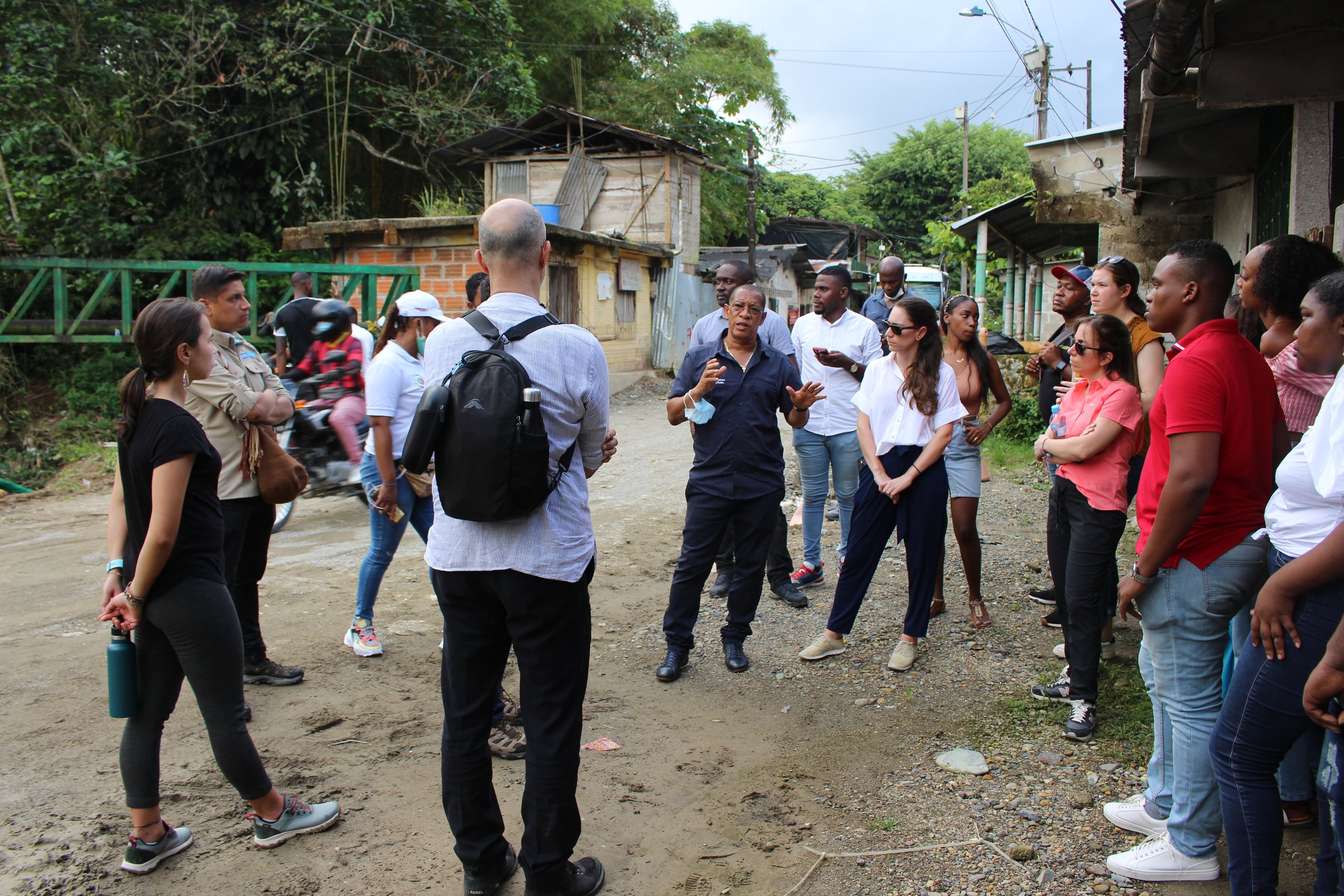Get to Know Marcela
October 3, 2022 | Interview by Emilia Charno
Marcela and the co-instructors and students of the Biodiversity and Cities class in a visit to the Humboldt Institute in Bogotá.
Resilient Ecosystems panel at Solve’s flagship event Solve at MIT 2022.
Marcela is an Environmental Planning Researcher and Research Program Director at the MIT Environmental Solutions Initiative (ESI). She also serves as the manager for the Colombia Program on Climate, Equity and Sustainable Development, a collaboration among researchers, environmental planning authorities and community groups aimed at reducing deforestation, environmental risk and socioeconomic vulnerability in the Amazonian and Pacific piedmonts. Marcela has a Masters in City Planning (MCP) from MIT and a Summa Cum Laude B.A in Architecture from Los Andes University in Bogotá, Colombia.
To start, can you share a bit about the journey that got you to where you are today professionally?
I started working on environmental planning while doing my Master’s at the MIT Department of Urban Studies and Planning. My background is in architecture, and I began my planning career working at the intersection of green infrastructure and public spaces. I also became involved in a project that touched on climate risks, monitoring, and community-based adaptation, which expanded my work into environmental topics more generally. Our work in Colombia started with a deep engagement process, and allowed us to build both institutional relationships and a research agenda that became the starting point for multiple research projects leveraging technology development and community-based planning . Through working with local groups in two strategic ecosystems in Colombia - the Amazon and Chocó - we identified local priorities and opportunities for MIT to collaborate combining topics like climate change and risk management, deforestation reduction, sustainable development, and biodiversity management in urban areas, among others. This is the origin of the pipeline of projects that became the program that I manage, the Natural Climate Solutions (NCS) Program at the MIT Environmental Solutions Initiative (ESI).
What would you like to share about MIT ESI?
ESI is one of the few initiatives at MIT that does not belong to any one school but rather is transversal to the Institute. At ESI we mobilize the MIT community around global environmental challenges. Our work spans topics such as mining, society, and the environment; plastics and the environment; cities and climate change; climate communications; natural climate solutions; and arts and climate change.
What are the values that drive your work?
Some of the most important values in my work are equity and inclusion, sustainability, and environmental justice. At ESI we are very conscious of the multidisciplinary nature of environmental work in achieving sustainable solutions. We actively seek opportunities to collaborate with diverse actors on the ground as well as diverse areas of knowledge at MIT. Particularly at NCS, participatory processes to identify local priorities and research opportunities have been at the heart of most of our research projects. Our goal is not to replace efforts but to be complementary and supportive to the capacities that already exist in local communities.
We embody a commitment to increase the participation of groups that have historically been marginalized and who are disproportionately affected by the effects of climate change. We know that equitable allocation of environmental funds is crucial for these groups, many of whom are also affected by socioeconomic inequality, structural poverty, racism, and lack of political representation, among others. As we create solutions, we want to increase these groups’ voices and agency.
In what ways can universities like MIT position themselves to play a unique, substantive role in combating the effects of the climate crisis?
A university like MIT works at the intersection of research, education, and engagement. It creates pathways for accelerating innovation and pipelines of solutions that come out of research labs. At the same time, a wide range of experiential learning opportunities strengthen the capacities of the next generation to continue to tackle environmental issues with deep understanding. It is also important to acknowledge the convening power of an institution like MIT to bring together scientists, public officials, and industry and community leaders who may not necessarily communicate often. Academia helps to frame conversations in such a way to outline solutions for government, industry, and communities.
Personally, at MIT I found a place to expand my knowledge and skills in community-based and technology-enhanced environmental planning while at the same time working to address the priorities identified through the engagement with local communities in Colombia. Our approach to addressing real, on-the-ground problems, has been an incredible opportunity to work in research in a very applied way. I’ve also been able to conduct my own research in the areas of urban biodiversity and city planning, while building bridges with other researchers at MIT to work in multidisciplinary climate change mitigation and adaptation projects in Latin America.
Where can people go to learn more about global efforts to combat climate change and key metrics - such as biodiversity, carbon capture, and deforestation - in an accessible way, MIT and others?
MIT ESI has a climate communications program that produces a series of resources accessible to the public and others targeted to educators, so that they can learn and work on issues of climate change more easily. This includes the Today I Learned: Climate podcast, which addresses some of today’s most pressing climate change questions with professors and practitioners. Each podcast episode comes along with guides for educators, specifically to be able to replicate some of the lessons shared in the classroom! There is also the MIT Climate Portal more broadly, which collects and captures climate research happening across MIT. MIT ESI also has a newsletter that goes out every week where we share more of our day-to-day activities - what we are reading, watching, and working on in addition to job and research opportunities!
What are 2-3 of the most pressing issues on your mind as an environmental planner?
If you are asking me about what keeps me up at night, part of it is the global biodiversity decline. This is a crisis that does not get as much attention as the climate crisis but, in some ways, is as critical to address as it could destabilize planetary ecology. Biodiversity should be tackled in tandem with climate, and we should target a set of solutions to specifically address these crises in tandem. To illustrate this with an example from urban planning, planting trees in cities has been proposed as a climate solution, but to enhance biodiversity through such an initiative there are many additional factors to consider. If you plant one million trees of the same species, without a deep consideration of how this affects local biodiversity, both communities and ecosystems, you would be missing the opportunity to address both issues.
There is also the equity question for all of the climate solutions. We need to acknowledge that environmental solutions, if implemented without attention to the impacts on vulnerable populations, could replicate existing inequalities or shift issues to another population down the line.
Our team at Kyanite Partners met you by collaborating to provide strategic support to the Afro-Interamerican Forum on Climate Change (AIFCC). Is there anything you would like to share about that project and/or working with our team at Kyanite Partners?
This particular project was launched by Luis Gilberto Murillo, former Minister of Environment of Colombia and former MLK fellow at ESI. Luis Gilberto saw a need to create a forum for Afro-descendant leaders to work together on climate action with a focus on natural climate solutions. Then, through conversations and engagement with a series of afro-descendant leaders from Colombia, Panamá, Brazil, and Honduras, among others, we identified three priority areas of work and opportunity: (1) mapping, documenting and highlighting the contributions of afro-descendant communities to the climate agenda, (2) fostering local innovation and natural climate solutions through community-based planning, and (3) uplifting the voices of Afro-descendant leaders in international climate policy forums. Part of the work that we’ve been doing so far has been building the network of Afro-descendant leaders in countries across Latin America who are working with local communities to implement successful models for sustainable development, natural resource conservation, environmental planning, and climate action.
We started working on this project with Kyanite Partners at an early stage - when it was just an idea! Part of the challenge and what we have been doing together is balancing an ambitious vision and ensuring that we are advancing on strategic steps and timely execution to build solid grounding for this initiative. Together, we have had critical conversations about the core values of the Forum and how to build consensus around them.
What is a place that has deeply shaped you?
I spent most of my life in Bogotá, Colombia, where I lived on a street at the city’s limit with the Eastern Mountains that are a natural reserve right next to my home, and I had the amazing opportunity to live in a city while hiking and accessing nature on a weekly basis. This helped grow my deep appreciation for nature and cities together.
Professionally, starting with the Department of Urban Studies and Planning and the Community Innovator’s Lab, MIT has provided theoretical grounding and experiential learning opportunities which helped me develop the work that I do now. Now, working in academia has provided me with an opportunity to think critically about global environmental challenges, while working on the solutions space . Working at ESI has been a natural continuation of the work that I started as a student at the Department of Urban Studies and Planning - and it has provided the resources and the leadership opportunity to grow this vision into a longer-term research program.
Is there anything that you’re reading or watching that’s inspiring you?
I’m currently reading Under a White Sky by Elizabeth Kolbert. I think it illustrates well some of the challenges we face with the climate crisis. It also addresses the types of problems and, sometimes, the unexpected consequences that humans create, when trying to address environmental problems, which is at the same time inspiring and eye-opening.
There is also the equity question for all of the climate solutions. We need to acknowledge that environmental solutions, if implemented without attention to the impacts on vulnerable populations, could replicate existing inequalities or shift issues to another population down the line.
Field visit with MIT students and members of the Environmental Youth Network in Quibdó, Colombia.
Presentation of Biodiversity and Cities collaboration results at the Ministry of Environment of Colombia.




